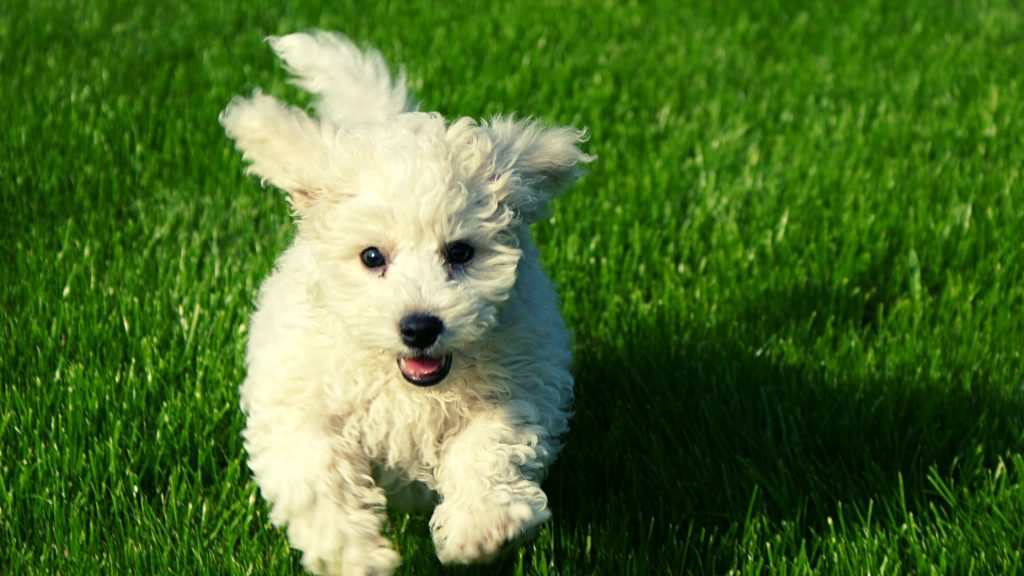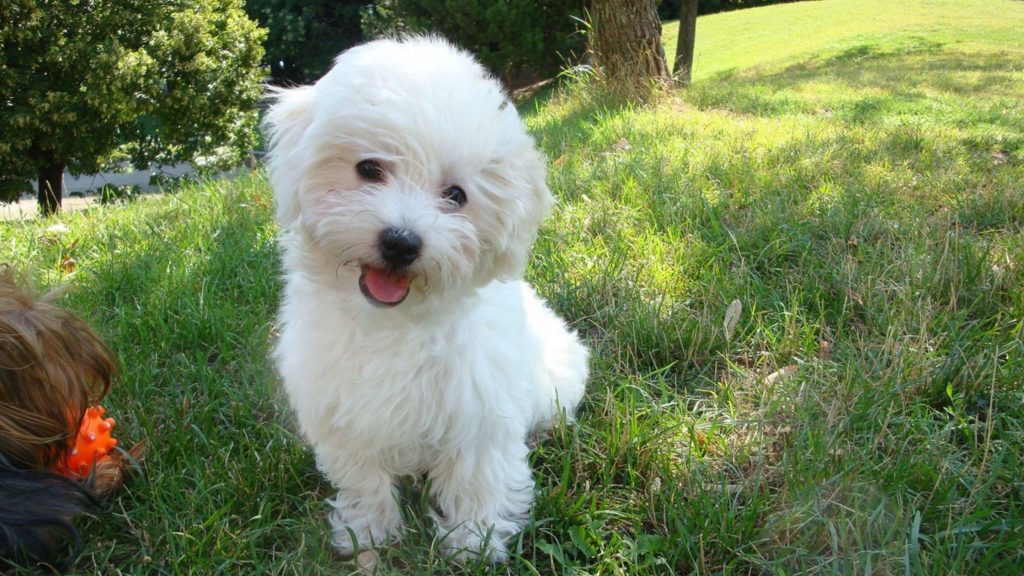The Bolognese Bichon is one of those dog breeds that dazzles us when we see it, since its white coat is spectacular and it has a captivating look, one of those that tells us that we are looking at a very alert dog.
- Weight : about 5 kilos
- Hair type : wool-like texture and curly
- Character : intelligent and very sociable, but distrustful of strangers
- Health : very good, although with some genetic diseases
- Life expectancy : between 12 and 14 years
origins
Although it is one of the dog breeds that was recognized late, the FCI did not do so until 1989 , the truth is that its history is much older.
Animals of a similar typology are already known in Roman times, and it seems that Aristotle already referred to them as “canes melitenses”, a name that was used when defining companion dogs in ancient times.
As always happens, these very ancient origins are not very clear, since there is no reliable way to verify that this is the case, but there is now less doubt that the Bolognese bichon, or very similar dogs, were highly appreciated in European courts. from the 11th century .
Later, in the 15th and 16th centuries, the popularity of these dogs continued at its peak, and in fact even Philip II thanked the Duke of Este for giving him two of them.
We can see it in paintings from the Renaissance
In this period of the Renaissance there is already evidence that a dog like this bichon existed, as it appears in some paintings by Titian, and the same in later centuries, since Goya painted it in the portrait of “The Duchess of Alba de white" .
A white dog very similar to the Bolognese bichon appears to the right of the duchess (on the left according to our perspective) with a red bow on one paw.
He is not the only famous person who had one of these white-furred dogs, but others such as Catherine the Great of Russia also owned some specimens of the breed.
Despite the popularity that this dog has had for centuries, after the Great War it was on the brink of disappearance. So much so, that if it were not for a group of Italian breeders, the Bolognese Bichon would have disappeared, this being the reason for its inclusion as a breed at such a late time.

Main features
Its main characteristic, and what distinguishes it from other breeds of companion dogs, is its white coat , which is very compact and is the result of selection, since it was originally brown. Right now, the standard only accepts the color white.
It has a single coat, without undercoat and is very curly, with a very soft texture to the touch that reminds us of wool when we touch it, which gives a very pleasant sensation and makes it look cottony or like a cloud.
His hair falls out like all dogs, even though they put him on lists where they say he doesn't lose hair. It is true that it loses less than other breeds, since its growth cycle is very slow.
The height does not usually exceed 30 cm maximum nor the weight 4 or 5 kilos , although there are specimens that can weigh around 2 kg, from which it is better to avoid, as they are a sure source of health problems. medium term.
Their black eyes stand out, very bulging, especially with that immaculate white coat, creating a contrast along with the nose that makes them even more striking, which is pink when they are born and darkens around three months of age.
Character of the Bichon Bolognese
It is a family dog and one of the best for people without experience , since due to its size it is easy to handle, being very attached to its owner and those who live with it.
He loves to be with his master and does not like to be separated from him, so perhaps he is not the best dog if we are not always going to be at home, since he will not be happy if we are separated from him for many hours a day.
In fact, those who live with the breed say that it is a bit heavy because it is always looking for the cuddles of its owner with whom it tries to sleep in bed, get on the couch with it, etc., so it is possible that we have to put some limits on it.
Due to this character, it can live with other dogs, as long as they are not aggressive, and it is an ideal breed when it comes to living with other pets , as is the case with most bichons.
Intelligent and good guardian despite his size
Another characteristic of its character is intelligence, so this, added to the fact that it always wants to please its owner, makes training it very simple, and hence it is a breed recommended for novices.
This intelligence is one of the “dangers” of the breed, since if we do not show him that we are the leader (which is not complicated with these dogs) he will soon discover our weak points and will use them when he sees fit.
With strangers, the character of the Bolognese changes completely. He is usually reserved and distrustful to such an extent that he is said to be a good guard dog, not because of his size or because he is intimidating, but because he immediately barks and alerts us to the presence of intruders.

Care of the Bichon Bolognese
Your cotton cloud or teddy bear appearance has a price to pay and that is the work we are going to have to do in order to always keep your hair in perfect condition.
To do this, you will have to brush it daily with a suitable comb , which can have quite open metal tines, always designed for soft hair and in which you will have to invest some money in order for it to be of quality, since we are going to be using every day of our dog's life.
It is important not to neglect brushing, since if we do so the hair will become a tangle of knots that are impossible to untangle, something that will lead to having to shave it and strip it of its essence.
You will also have to visit the hairdresser several times a year and there we should ask for a good shampoo, since many of the ones on the market (especially the cheapest ones) can turn your hair yellow, which is a shame.
As for exercise, like all dogs, he needs to go outside several times a day, but he is not going to ask us to be outside for hours nor is he a dog to play sports with . In fact, it is an ideal breed for older people, who walk at a gentle pace every day.
Finishing this section, we must keep in mind that it is not a dog that can be alone. It's okay if one day we have to go away and leave it at home, but if we are away a lot, we will have to look for a more independent breed.
Feeding
You have to be careful when feeding the Bolognese Bichon, since we tend to give it everything we eat and that makes it gain weight, something we should avoid.
The best way to get the right feed is to ask the breeder who sells us the dog, who will know the breed well and will be able to make a recommendation based on his years of experience feeding them.
In any case, it is enough to buy a good quality feed, with natural ingredients and without preservatives or colorings, which we will find in any specialized store or veterinary clinics.
It is very important that in this case the feed does not have artificial coloring, since otherwise it is possible that the white hair begins to turn yellow , which can also happen with quality ones if they contain corn or carrots.
The food must have a small kibble, adapted to its mouth, and in the end the choice is made by trial and error, trying several brands until we find the one that best suits our bichon.

Bichon Bolognese Health
Here there is a drawback that has to do with the almost disappearance of the breed, and that is that the breeders had to recover it with what they had, which meant many problems derived from inbreeding.
In fact, any breeder who has been with the Bolognese Bichon for years can tell us that they have been working to improve aspects such as the longevity of the breed, which was not the best, although that has now been overcome.
Among hereditary diseases we can name patella luxation and eye problems such as retinal atrophy , both very common in bichons and here perhaps a little more frequent due to the problems we mentioned before.
They also have another disease called white dog shaker syndrome. This consists of a tremor that is annoying, but does not harm the animal's health and seems to have something to do with stressful situations.
Obesity is another pathology that has more to do with us than with the dog, since with these breeds there is always a tendency to give it whims and extra foods that should not be included in its diet, although luckily it is easy to tackle.
If we see that he is gaining weight, it is best to talk to the vet and use a light feed , always avoiding giving him whims that do him no good.
Other dog breeds that may interest you:












